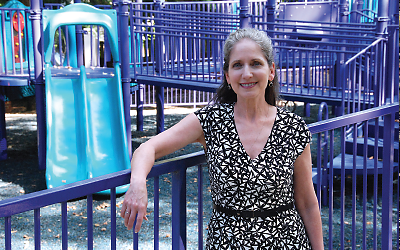Children With Autism Learn From Peers in Novel Program
Abstract
“All the world’s a stage,” said Shakespeare, and sometimes the stage is a good place for kids with autism to prepare for the world.

What the rest of the world considers recreation, Vanderbilt University’s Blythe Corbett, Ph.D., sees as a laboratory and a new place to test therapy for children with autism.
A theater and a leafy playground are unlikely venues for research or therapy, yet those are laboratories for Blythe Corbett, Ph.D., an assistant professor of psychiatry at Vanderbilt University.
“Those places can inspire psychologists and psychiatrists to think beyond our traditional therapies and utilize novel treatments and experiences that are out there but that we are not thinking about,” said Corbett in a recent interview in her campus office.
The large, tree-shaded playground nearby contains a maze of elevated purple-painted steel walkways. Corbett sends 8- to-12-year-old children out to play in groups of three. One child has been diagnosed with autism. The second, matched for age and gender, is a typically developing young person (“peer” in Corbett’s terms) who acts as a control subject. The third is a “confederate,” a sort of junior research assistant, recruited by Corbett for his or her “natural social abilities,” she said. All the children carry small radio units with microphones in belt pouches so researchers can listen to and record their conversations. The confederates also wear earphones to listen for instructions from the researchers.
Sometimes the kids just play, but at key moments, Corbett or one of her graduate students radios the confederates to engage the others in play or to have them break off and play again on their own.
The interactions are recorded by four video cameras, and the research team codes the children’s behavior for later analysis.
“During free play, the children with autism act much like the typically developing kids,” said Corbett. “But when a confederate solicits play, they are less cooperative, show less verbal initiation, and are more likely to say ‘no thanks’ when invited to play.”
Corbett’s team has used the system for several years, initially to observe behavior for its own sake. Now they also use play as a means to measure changes first seen in treatment in a real-world setting.
For instance, following a two-week intervention, children with autism demonstrate a level of play similar to their pretreatment levels, she said. She has found that to improve their play, those children often need someone familiar—a child with whom they’ve played before—to serve as a “bridge” to a new play situation.
“They need a little bit of scaffolding to transfer a newly learned social skill to another environment,” she said.
With adolescents, Corbett uses the electronic game Wii rather than the playground as a play setting. She also runs the adolescents through a social-stress test—giving a speech before an audience of impassive adult authority figures in white lab coats.
“The teens with autism do not find it stressful, as measured by a rise in cortisol, but the typically developing ones do, which is appropriate,” she said. “Perhaps the adults are not perceived as stressors by those with autism.”
A second avenue of research leads Corbett back to an earlier career as a professional actor and writer.
She created the SENSE Theatre, a two-week, half-day summer camp, when she was at the University of California, Davis. (SENSE stands for Social Emotional NeuroScience Endocrinology.) Children and adolescents with autism learn acting techniques such as role-playing, improvisation, and performance from trained, typically developing youth actors. The youth actors and camp counselors also blend in classical behavioral strategies such as positive reinforcement or extinction to improve the social skills of the children with autism.
Corbett writes the scripts herself. She can modify a character or expand or shorten a child’s role, depending on the young actor’s capabilities.
“We usually think of theater as a recreational activity, but actors learn to master social communication and think flexibly, the very skills that people with autism need to learn,” she said.
Pre- and post-tests of young people in the theater program show an improvement in identification of and memory for faces, ordinarily a problem for children with autism, she noted. There is also an initial rise in stress levels (as measured by cortisol) followed by a reduction as they habituate and adapt to the new environment.
Corbett sees wider lessons in her work for studying and treating children with autism or other disorders.
“When you have a condition in which interaction with peers is impaired, then there is a need for peers to be a part of the treatment,” she said. “Children with autism learn from those who matter to them, but also can learn to generalize from those experiences.” ■
Information about the SENSE lab at Vanderbilt University is posted at http://kc.vanderbilt.edu/senselab.



